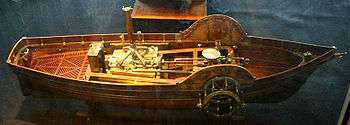Claude-François-Dorothée, marquis de Jouffroy d'Abbans
Claude-François-Dorothée, marquis de Jouffroy d'Abbans (30 September 1751 – 18 July 1832) is claimed to be the first inventor of the steamboat.
In 1773, Jouffroy d'Abbans met with the Perier brothers and studied in their workshop the Pompe à feu (Fire pump), which had been used as a motive force for the hydraulic machine developed by Chaillot, in order to apply to ship propulsion.
In 1776, Jouffroy d'Abbans develop a 13-meter steamship, the Palmipède, in which the engine moved oars equipped with rotating blades. The ship sailed on the Doubs in June and July 1776.

In 1783, he made a paddle steamer named the Pyroscaphe ply on the Saône. However, the Académie des Sciences prohibited him from using his invention in Paris, and instead nominated Perier, one of d'Abbans' opponents whose previous attempts had failed, to inspect the project. Further misfortunes due to the French Revolution hindered his progress. His claim was acknowledged by Arago and in 1840 by the French Academy. Jouffroy published Les bateaux à vapeur and wrote for the Academy Mémoires sur les pompes à feu. Impoverished, he retired to the Hôtel des Invalides and died there of cholera.
In 1803, more than 20 years after d'Abbans' inaugural trip, Robert Fulton would succeed in sailing a steamship of his conception on the Seine.
External links
This article incorporates text from a publication now in the public domain: Wood, James, ed. (1907). "article name needed". The Nuttall Encyclopædia. London and New York: Frederick Warne.